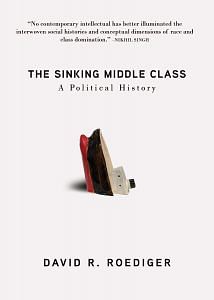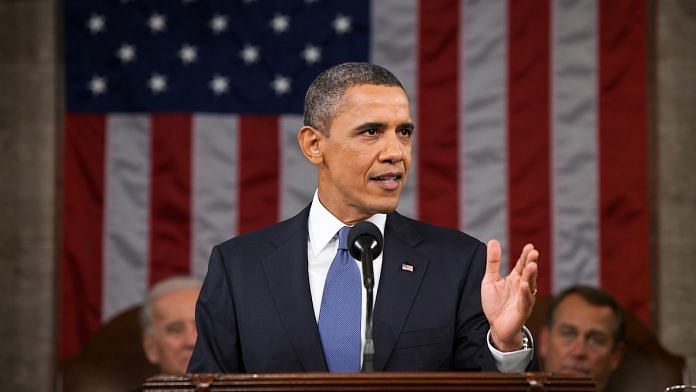Democrats and Republicans vie for the lead in terms of promises to stand up for the putatively noble but chronically fragile middle strata of the class structure. Both parties praise the middle class as the broken heart of the nation and hold that only they can mend it.
The 2012 presidential elections typified the relentless appeals to the supposed center of the social structure. In February 2012, the political scientist Cal Jillson concluded that president Barack Obama had “settled on a message of middle-class support.” Jillson correctly predicted that, knowing they “were on to something,” the Obama strategists would be systematically pursuing the issue throughout the campaign. Obama, hardly silent regarding professing his love for the middle class before that point, redoubled his commitment by declaring himself a “warrior” for that group in pursuing reelection. Practically the first act of the Obama presidency’s first term had been to set up the Middle Class Task Force, led by vice-president Joe Biden. Charged with getting “the backbone of this country up and running again”; the initiative identified a “strong middle class” with a “strong America.” To speak even louder about those in the middle class in 2012, Obama was careful to insist, was not about “class warfare.” Instead, it concerned the “nation’s welfare.” The “make or break moment for the middle class,” Obama argued first at a small high school gym in Kansas and then to the nation, defined the stakes of the election.
By July 2012, a typical short Obama campaign speech would feature more than a dozen invocations of the glorious, precarious “middle class.”
Also read: Under Trump, American middle class is united on foreign policy but distrusts officials
The Republicans faced the difficult fact that polls showed Obama clearly besting GOP candidate Mitt Romney in being trusted to look out for middle-class economic interests. The two presidential campaigns even shared a definition of middle class: those making less than $250,000—sometimes Romney mentioned $300,000—a year, upwards of 96 percent of the population. The 96% was not so much a class as it was a nation. To wage political war on its behalf seemed good patriotic politics.
An appeal to the middle class worked, wrote political scientist Mark Sweet, because “most people describe themselves as middle class.” The political wisdom that winning the middle-class vote predicted electoral victories could hardly have failed so long as almost all the electorate could be wrangled into that group.
Ironically it was the avowedly socialist candidate, Bernie Sanders, who most insistently positioned himself as the candidate of, and in some measure from, the middle class. After losing the nomination, he stumped on Clinton’s behalf, including in Michigan venues her campaign ignored. “What this campaign is about,” he told a crowded rally for her at the United Automobile Workers hall in Dearborn, “is the survival of the middle class.”
Trump campaigned on the idea of a “middle class tax cut,” while lacing the term “working families”—one that for me conjured up child labor when spoken by him—into his tax reform rhetoric. It was a campaign of awkward silences on class generally. Trump presented himself as a modern political leader uniquely unmoved by pretending affinity with the middle class. He bragged repeatedly of his 1 percent status. Overemphasizing his self-made success and deemphasizing his debts, he courted being seen as filthy rich. Hillary Clinton meanwhile only rarely rehearsed economic worries she experienced growing up.
Also read: Three economists went around India asking: do you call yourself middle class?
The hottest controversies over the size of the middle class have come from the left, and especially from writer-activists in the developing field of working-class studies. In rejecting the idea that an overwhelming majority of Americans are members of the middle class, Michael Zweig, longtime professor of economics at the University of Stony Brook, and labor studies educator Jack Metzger offer critiques turning on how “middle class” is defined. They point out that surveys in which the term “working class” is absent from the choices offered to respondents artificially inflate the numbers of those choosing a middle-class self-identification.
Zweig cites cases in which, in the absence of a working-class alternative, an overwhelming majority choose middle class. With a working-class category on offer, the proportion choosing to identify as middle class drops to less than half.
Many factors conspire to lead US citizens to think “white middle class” when they hear the words “middle class.” Patterns of who has historically done hard manual labor and of relative access to education have left whites overrepresented in professional, white collar, and managerial labor. Loose talk of saving the middle class obscures this past and present.
“Middle class” had at times seemed the property of white segregationist Democrats and at others of Republicans on the right, but overwhelmingly on the local and state level, not nationally.
Also read: You know me. Do I look like a radical socialist? — Biden hits back at Trump
A 2013 study by the Center on Applied Research at Georgetown University comparing language used by the last ten presidents in public statements and official communications involving social class underlined this point.
Obama mentioned “middle class” in just over half such statements, taking the leading position in its use. Bill Clinton, who came in second, used it only half as much. Obama occupied last place in references to the “poor” and to “poverty,” mentioning them in only 26 percent of his statements, about half the figure for the next lowest, George H.W. Bush. In contrast, Lyndon Johnson referred to poverty in 84 percent of such communications and used middle class just 1 percent of the time. No president from late 1963 until early 1981 used middle class in more than 3 percent of their communications regarding class. Things changed. And things stayed changed.
Further evidence of the late arrival of “middle class” in US discourse comes from the 1920s classic work of community sociology, Middletown, by Robert S. Lynd and Helen Merrell Lynd. The Lynds studied Muncie, Indiana, a middle-sized and Middle American city in what remains the best sociological account of a white community yet produced in this country. They used “middle class” just four times in a 550-page book, and only once substantively.
In February 1940, the then-stylish business magazine Fortune produced a breakthrough for the idea of a middle-class nation in popular media. The magazine expanded its regular “Fortune Survey” feature into a fat special issue developing a “self-portrait” titled “People of the U.S.A.” The very first subheading affirmed a foundational fact: “The U.S. Is Middle Class.” Those it identified as the “people,” that collective noun so dear to the left at the time, roughly equaled the middle class. A spectacular statistic, if not fact, anchored the argument: 79.2 percent of respondents identified as members of the middle class even as the decade of the Great Depression and mass industrial unionism ended. With recovery still far from complete, supposedly only a quarter of factory workers described themselves as “laboring” or “working” class. Most of those Americans responding as middle class specified “middle middle” if they offered a further adjective. Less than 3 percent opted for “upper” or “upper-middle” class. As Fortune put it, there were “singularly few people,” even executives, who were “willing to tag themselves as anything more than plain ‘middle class.’”
 This excerpt from The Sinking Middle Class: A Political History by David R. Roediger has been published with permission from OR Books. Use the coupon code ‘THESINKINGMIDDLECLASS’ to get 20% off on all book formats.
This excerpt from The Sinking Middle Class: A Political History by David R. Roediger has been published with permission from OR Books. Use the coupon code ‘THESINKINGMIDDLECLASS’ to get 20% off on all book formats.




Unbelievable, the article is about numbers but no numbers are given…..